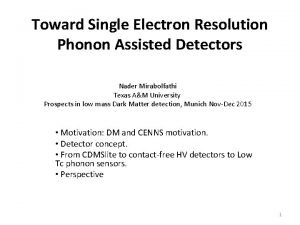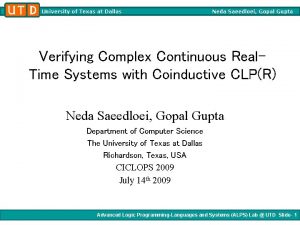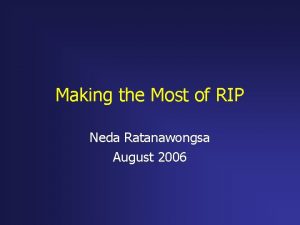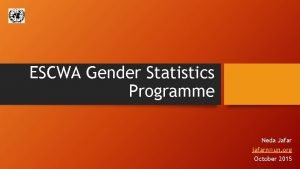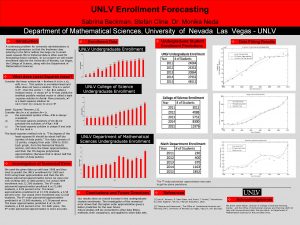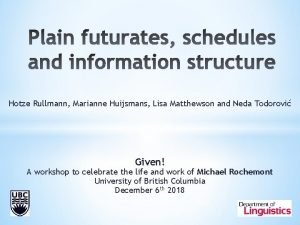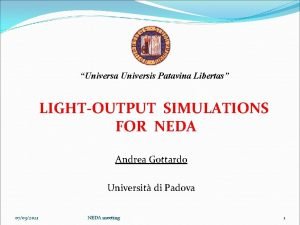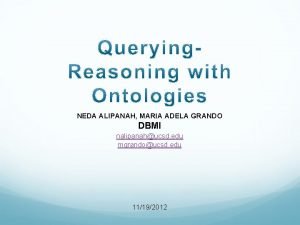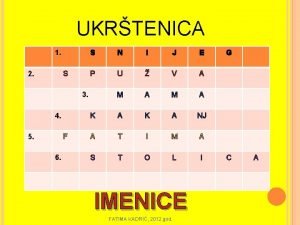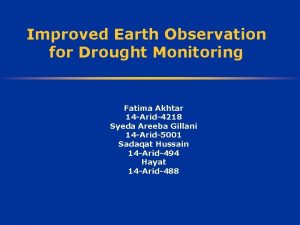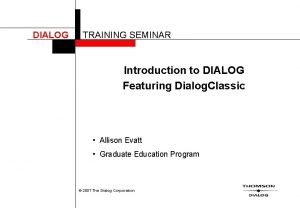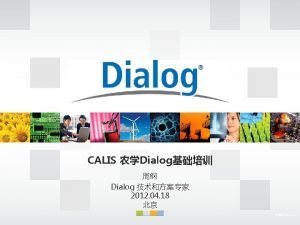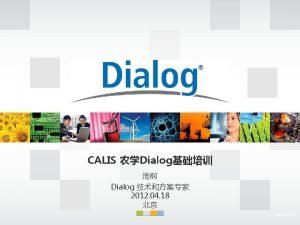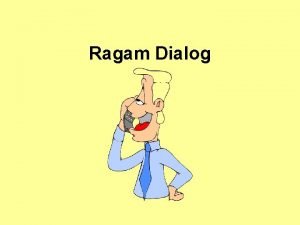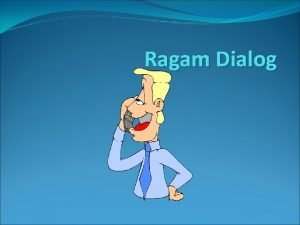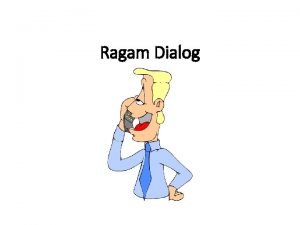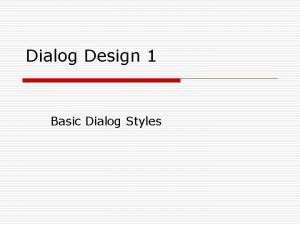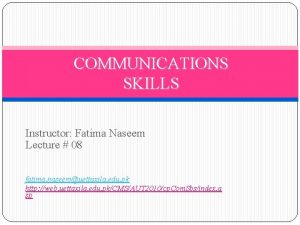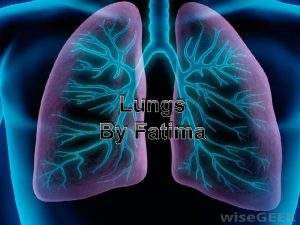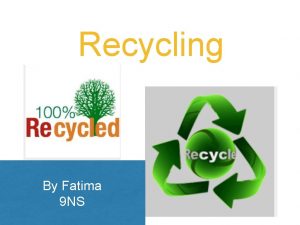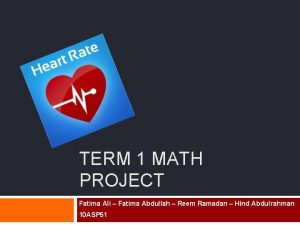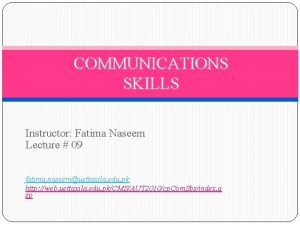Fatima Fahimniaut ac ir Nader Naghshineh Dialog neda































- Slides: 31

Fatima Fahimnia@ut. ac. ir Nader Naghshineh Dialog @neda. net

Outlines • Introduction • Overview • Visualization Classification • A Framework for Information Visualization • Emerging Information Visualization Applications • Evaluation Research for Information Visualization • Summary and Future Directions

Introduction… • Collecting information is no longer a problem, but extracting value from information collections has become progressively more difficult. • Visualization links the human eye and computer, helping to identify patterns and to extract insights from large amounts of information • Visualization technology shows considerable promise from increasing the value of large-scales collections of information

Introduction… • Visualization has been used to communicate ideas, to monitor trends implicit in data, and to explore large volumes of data from hypothesis generation. • Visualization can be classified as scientific visualization, software visualization, and information visualization. • This paper reviews information visualization techniques developed over the last decade and examines how they have been applied in different domains

Outlines • • • Introduction Overview Visualization Classification A Framework for Information Visualization Emerging Information Visualization Applications Evaluation Research for Information Visualization • Summary and Future Directions

Overview of Visualization • Although visualization is a relatively new research area, visualization has a long history – First known map: 12 th century (Tegarden, 1999) – Multidimensional representations appeared in 19 th century (Tufte, 1983) • In scientific fields – Bertin (1967) identified basic elements of diagrams in 1967 – Most early visualization research focused on statistical graphs (Card et al. , 1999) – Data explosion in 1980 s (Nielson, 1991) – NSF launched the “Scientific visualization” initiative in 1985 – IEEE 1 st visualization conference in 1990

Overview of Visualization… • In nonscientific contexts – “information visualization” was first used in Robertson et al. (1989) – Early information visualization systems emphasized • interactivity and animation (Robertson et al. , 1993) • Interfaces to support dynamic queries (Shneiderman, 1994) • Layout algorithms (Lamping et al. , 1995) – Later visualization systems emphasized • • • Subject hierarchy of the Internet (H. Chen et al. , 1998) Summarizing the contents of a document (Hearst, 1995) Describing online behaviors (Donath, 2002; Zhun & Chen, 2001) Displaying website usage patterns (Erick, 2001) Visualizing the structures of a knowledge domain (C. Chen & Paul , 2001) • Information also needs the support of information analysis algorithms (H. Chen et al. , 1998) • The lack of thorough, summative approaches to evaluating existing visualization systems has become increasingly apparent ( C. Chen & Czerwinskim, 2000)

Overview of Visualization… • A Theoretical Foundation for Visualization – Human eye can process many visual cues simultaneously (Ware, 2000) – People have a remarkable ability to recall pictorial images (Standing et al. , 1970) – Visual aids people to find patterns – But Patterns will be invisible if they are not presented in certain ways – Understanding visual perception can be helpful in the design of visualization system

A Theoretical Foundation for Visualization • Different parts of human memory can be enhanced by visualization in different ways (Ware, 2000) – Iconic memory is the memory buffer where pre-attentive processing operates • Certain visual patterns can be detected at this stage without having to go through the cognition process • Visual processing channel theory (Ware, 2000) • Design effective visualizations reply on understanding the perception of patterns – Working memory integrates information from iconic memory and long-term memory for problem solving • Patterns perceived by pre-attentive processing are mapped into patterns of the information space • Visualization can serve as an external memory, saving space in the working memory. – Long-term memory stores information in a network of linked concepts (Collins & Loftus 1975, Yufik & Sheridan 1996) • Using proximity to represent relationships among concepts in constructing a concept map has a long history • Visualization also use proximity to indicate semantic relationships among concepts

Outlines • • • Introduction Overview Visualization Classification A Framework for Information Visualization Emerging Information Visualization Applications Evaluation Research for Information Visualization • Summary and Future Directions

Visualization Classification • Scientific Visualization – Scientific visualization helps understanding physical phenomena in data (Nielson, 1991) – Mathematical model plays an essential role – Isosurfaces, volume rendering, and glyphs are commonly used techniques • Isosurfaces depict the distribution of certain attributes • Volume rendering allows views to see the entire volume of 3 D data in a single image (Nielson, 1991) • Glyphs provides a way to display multiple attributes through combinations of various visual cues (Chernoff, 1973)

Visualization Classification… • Software Visualization and Information Visualization – Software visualization helps people understand use computer software effectively (Stasko et al. 1998) • Program visualization helps programmers manage complex software (Baecker & Price, 1998) – Visualizing the source code (Baecer & Marcus, 1990) data structure, and the changes made to the software (Erick et al. , 1992) • Algorithm animation is used to motivate and support the learning of computational algorithms – Information visualization helps users identify patterns, correlations, or clusters • Structured information – Graphical representation to reveal patterns. e. g. Spotfire, SAS/GRAPH, SPSS – Integration with various data mining techniques (Thealing et al. , 2002; Johnston, 2002) • Unstructured Information – Need to identify variables and construct visualizable structures. e. g. antage Point, Semio. Map, and Knowledgist

Visualization Classification • Scientific Visualization – Scientific visualization helps understanding physical phenomena in data (Nielson, 1991) – Mathematical model plays an essential role – Isosurfaces, volume rendering, and glyphs are commonly used techniques • Isosurfaces depict the distribution of certain attributes • Volume rendering allows views to see the entire volume of 3 D data in a single image (Nielson, 1991) • Glyphs provides a way to display multiple attributes through combinations of various visual cues (Chernoff, 1973)

Outlines • • • Introduction Overview Visualization Classification A Framework for Information Visualization Emerging Information Visualization Applications Evaluation Research for Information Visualization • Summary and Future Directions

A Framework for Information Visualization • Research on taxonomies of visualization – Chuah and Roth (1996) listed the tasks of information visualization – Bertin (1967) and Mackinlay (1986) described the characteristics of basic visual variables and their applications. – Card and Mackinlay (1997) constructed a data type-based taxonomy. – Chi (2000) proposed a taxonomy based on technologies. • Four stages: value, analytic abstraction, visual abstraction, and view – Shnederman (1996) identified two aspects of visualization: representation and user-interface – C. Chen (1999) indicated that information analysis also helps support a visualization system • Three research dimensions support the development of an information visualization system – Information representation – User interface interaction – Information analysis

Information Representation Shneiderman (1996) proposed seven types of representation methods: – – – – 1 -D 2 -D 3 -D Multidimensional Tree Network Temporal approaches

Information Representation… • A visualization system usually applies several methods at the same time • Some representation methods also need to have a precise information analysis technique at the back end • The “small screen problem” (Robertson et al. , 1993) is common to representation methods of any type. – Integrated with user-interface interaction

A Framework for Information Visualization • User-Interface Interaction – Immediate interaction not only allows direct manipulation of the visual objects displayed but also allows users to select what to be displayed (Card et al. , 1999) – Shneiderman (1996) summarizes six types of interface functionality • • • Overview Zoom Filtering Details on demand Relate history

A Framework for Information Visualization… • User-Interface Interaction – Two most commonly used interaction approaches: • Overview + detail – First overview provides overall patterns to users; then details about the part of interest to the use can be displayed. (Card et al. , 1999) – Spatial zooming & semantic zooming are usually used • Focus + context – Details (focus) and overview (context) dynamically on the same view. Users could change the region of focus dynamically. – Information Landscape( Andrews, 1995) – Cone Tree (Robertson et al. , 1991) – Fish-eye (Furnas, 1986)

A Framework for Information Visualization… • Information Analysis – To reduce complexity and to extract salient structure – Two stages of information analysis • Indexing • Analysis

A Framework for Information Visualization… • Two stages of information analysis – Indexing • Extract the semantics of information • Automatic indexing(Salton, 1989) represents the content of each document as a vector of key terms – Natural language processing noun-phrasing technique can capture a rich linguistic representation of document content (Anick & Vaithyanathan, 1997) – Most noun phrasing techniques rely on a combination of part-of-speech -tagging (POST) and grammatical phrase-forming rules – MIT Chopper Nptool (Coutilainen, 1997) – Arizona Noun Phraser (Tolle & Chen 2000) • Information extracts entities from textual documents – Most information extraction approaches combine machine learning and a rule-based or a statistical approach – System that extracting entities from New York Times (Chinchor, 1998)

A Framework for Information Visualization… • • • Introduction Overview Visualization Classification A Framework for Information Visualization Emerging Information Visualization Applications Evaluation Research for Information Visualization • Summary and Future Directions

Emerging Information visualization Apps. • Digital Library Visualization – Browsing – Searching • Web Visualization – Visualization of a single website – Visualization of a collection of websites • Virtual Community Visualization – Tools for communication management – Tools for community analysis

Browsing a Digital Library Cancer. Map (Chen et al, 2003)

Visualization of a single Website Star. Tree by In. Xight

Outline • • • Introduction Overview Visualization Classification A Framework for Information Visualization Emerging Information Visualization Applications Evaluation Research for Information Visualization • Summary and Future Directions

Evaluation Research of Information Visualization • Empirical usability studies – To understand the pros and cons of specific visualization designs or systems – Laboratory experiments approach • Comparing a glyph-based interface and a text based interface (Zhu & Chen 2001) • Comparing different visualization techniques (Stasko et al. , 2000) – De-featuring approach • Several studies have been conducted to evaluate popular tree representations, such as Hyperbolic Tree (Pirolli et al. , 2000), Treemap (Stasko et al. , 2000), and multilevel SOM (Ong et al. , in press) – Complex, realistic, task-driven evaluation studies have been conducted frequently, e. g. (Pohl & Purgathofer, 2000; Risden et al. , 2000; North and Shneiderman, 2000). They could measure usefulness. But it is difficult to identify each visualization factors’ contribution. – Behavioral methods also need to be considered

Evaluation Research of Information Visualization… • Fundamental perception studies and theory building – To investigate basic perceptual effects of certain visualization factors or stimuli – Theories from psychology and neuroscience are used to understand the perceptual impact of visualization parameters as animation (Bederson & Boltman, 1999), information density (Pirolli et al. , 2000), 3 -D effect (Tavanti & Lind, 2001)and combinations of visual cues (Nowell et al. , 2002) – It usually involves some form of computer-based visualization • Bederson and Boltman (1999) used the Pad++ to study the impact of animation of users’ learning of hierarchical relationships • Pirolli et al. (2000) used a hyperbolic tree with fish 0 eye view to study the effect of information density. – Results may be applied only to the particular visualization system understudy

Outline • • • Introduction Overview Visualization Classification A Framework for Information Visualization Emerging Information Visualization Applications Evaluation Research for Information Visualization • Summary and Future Directions

Summary and Future Directions • This paper reviewed information visualization research based on a framework of information representation, user 0 interafact interaction, and information analysis • Although this paper focuses on the visualization of textual information, many associated techniques can be applied to multimedia visualization. • Information visualization can help people gain insights from large-scale collections of unstructured information

Summary and Future Directions… • Future Directions – Visual Data Mining • To identify patterns that a data mining algorithm might find difficult to locate • To support interaction between users and data • To support interaction with the analytical process and out put of a data mining system – Virtual Reality-Based Visualization • To take advantage of the entire range of human perceptions, including auditory and tactile sensations – Visualization for Knowledge Management • To facilitate knowledge sharing and knowledge creation • To accelerate internalization by presenting information in an appropriate format or structure or by helping users find, relate, and consolidate information and thus helping to form knowledge. (C. Chen & Paul, 2001; Cohen, Maglio & Barrett, 1998; Foner, 1997; Vivacqua, 1999) • From “information visualization” to “knowledge visualization”
 3ème prophétie de fatima - secret de fatima
3ème prophétie de fatima - secret de fatima Ragam dialog (dialog style)
Ragam dialog (dialog style) Sifat ragam dialog
Sifat ragam dialog Nader amin-salehi
Nader amin-salehi Samaneh kakavand
Samaneh kakavand Assis prof
Assis prof Francois nader
Francois nader Nader alaridah
Nader alaridah Nader alaridah
Nader alaridah Nader ahmadi
Nader ahmadi Nader pin
Nader pin Nader mirabolfathi
Nader mirabolfathi Amjad nader
Amjad nader Enes bin mâlik zayed bin malek
Enes bin mâlik zayed bin malek Australij
Australij Array
Array History of provolone cheese
History of provolone cheese Neda saeedloei
Neda saeedloei Neda lesar
Neda lesar Neda jafar
Neda jafar Neda soydan
Neda soydan Neda lesar
Neda lesar Neda ibrahim
Neda ibrahim Sabrina cline
Sabrina cline Hotze rullmann
Hotze rullmann Neda soydan
Neda soydan Neda moini
Neda moini Neda soydan
Neda soydan Adela grando
Adela grando Ivfet
Ivfet Vlastite imenice primjer
Vlastite imenice primjer Syeda areeba fatima biography
Syeda areeba fatima biography











